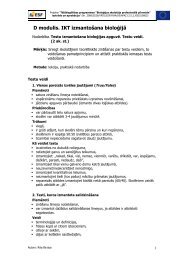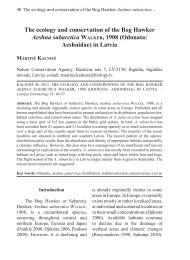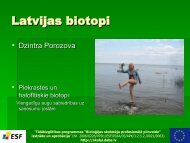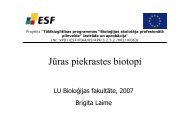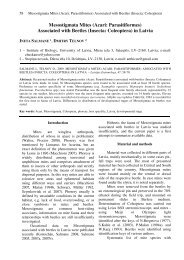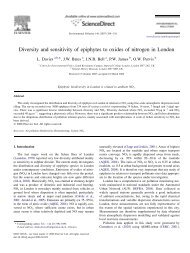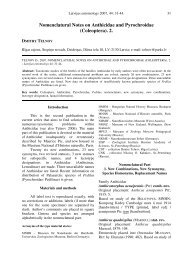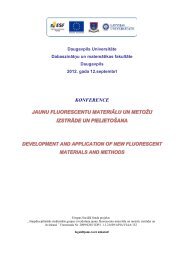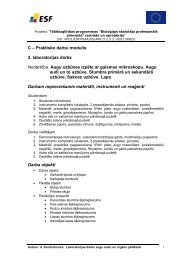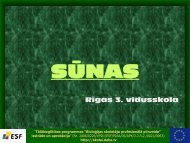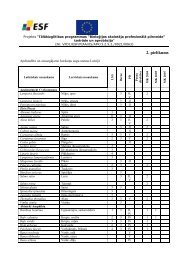Odonata - Entomological Society of Latvia - Latvijas Daba
Odonata - Entomological Society of Latvia - Latvijas Daba
Odonata - Entomological Society of Latvia - Latvijas Daba
You also want an ePaper? Increase the reach of your titles
YUMPU automatically turns print PDFs into web optimized ePapers that Google loves.
5. CONCLUSIONS<br />
1. In line with the latest investigations, there are 59 dragonfly species in <strong>Latvia</strong>. The changes in<br />
<strong>Latvia</strong>n dragonfly fauna in the last 20 years are related to the extension <strong>of</strong> southern species<br />
areas in the northern direction. In future 5 new dragonfly species may be identified in<br />
<strong>Latvia</strong> – Lestes viridis, Erythromma viridulum, Aeshna affinis, Orthetrum coerulescens un<br />
Sympecma fusca, while the total number <strong>of</strong> new species in a larger period <strong>of</strong> time might<br />
reach 12 species. The foreseen changes in the dragonfly fauna are related to the distribution<br />
<strong>of</strong> southern species in the northern direction.<br />
2. The distribution <strong>of</strong> separate dragonfly species in <strong>Latvia</strong> is very irregular, as <strong>Latvia</strong> lays in<br />
the periphery <strong>of</strong> the species’ area (Coenagrion johanssoni) and due to disjunctive<br />
distribution <strong>of</strong> species habitat (Gomphus flavipes, Aeshna subarctica) and climate changes<br />
(Anax parthenope, Sympetrum fonscolombii, Sympetrum pedemontanum).<br />
3. The variety <strong>of</strong> dragonfly species found in raised bogs is increased by the presence <strong>of</strong> water<br />
pools in open landscape (less common are pools in pine groves). Low variety <strong>of</strong> species is<br />
found in wooded mire (wooded [pine groves] mire landscape with mounds and depressions)<br />
and open mire (open mire landscape with mounds and depressions, but with no water bodies<br />
or woods) habitats. For dragonflies, the most important structures are open water and Ledum<br />
palustre, Vaccinium uliginosum, Calluna vulgaris and Andromeda polifolia vegetation<br />
structures.<br />
4. In the research <strong>of</strong> river dragonflies Gomphidae it was found that Gomphus vulgatissimus is<br />
an ecologically flexible species and the highest density <strong>of</strong> population can be found in micro<br />
habitats with sand and mud (and lower speed <strong>of</strong> the stream). Onychogomphus forcipatus, on<br />
the other hand, is less flexible and the highest density <strong>of</strong> larvae population is found in micro<br />
habitats with gravel, pebbles and cobbles (and higher speed <strong>of</strong> the stream). For<br />
Ophiogomphus cecilia the density <strong>of</strong> larvae population is relatively low, but no specific<br />
micro habitats were identified in <strong>Latvia</strong>.<br />
5. In <strong>Latvia</strong>, contrary to other European countries, Nehalennia speciosa may populate both<br />
small and large water bodies, if the vegetation is appropriate for the species. The distribution<br />
<strong>of</strong> the species in <strong>Latvia</strong> is most likely determined by the climate – the level <strong>of</strong> moisture and<br />
continentality <strong>of</strong> the climate. Fundamental differences regarding the vegetation populated by<br />
the species and the size <strong>of</strong> populations were not established.<br />
6. Aeshna subarctica in <strong>Latvia</strong> populates raised bogs with water pools and lakes and lakes with<br />
fen and poor fen banks, but, unlike in other European countries, it is not found in peat<br />
quarries. The distribution <strong>of</strong> the species in <strong>Latvia</strong> is most likely determined by the climate –<br />
the level <strong>of</strong> moisture and continentality <strong>of</strong> the climate. Fundamental differences regarding<br />
the size <strong>of</strong> the populated water bodies and populations were not established.<br />
7. Ophiogomphus cecilia in <strong>Latvia</strong> populates similar river habitats as in other places in the<br />
species area. Unlike in case <strong>of</strong> the part <strong>of</strong> the species area on the south from <strong>Latvia</strong>, in<br />
<strong>Latvia</strong> the distribution <strong>of</strong> the species is more determined by the climate – the level <strong>of</strong><br />
moisture and continentality <strong>of</strong> the climate.<br />
8. The population <strong>of</strong> Leucorrhinia family dragonflies in <strong>Latvia</strong>, in comparison with the<br />
population <strong>of</strong> this species in other places in Europe, is quite small. L. albifrons are more<br />
<strong>of</strong>ten found in dystrophic (acidic) lakes and also habitats <strong>of</strong> anthropogenic origin;<br />
L. caudalis comparatively <strong>of</strong>ten can be found in oxbow lakes, which is more characteristic<br />
to the periphery <strong>of</strong> the species area; the number <strong>of</strong> new localities <strong>of</strong> L. pectoralis has grown<br />
considerably, despite the downward tendency in Europe. The habitats suitable for these<br />
species are characterized more by the vegetation <strong>of</strong> the habitat rather than its origin<br />
(naturalism).<br />
78



